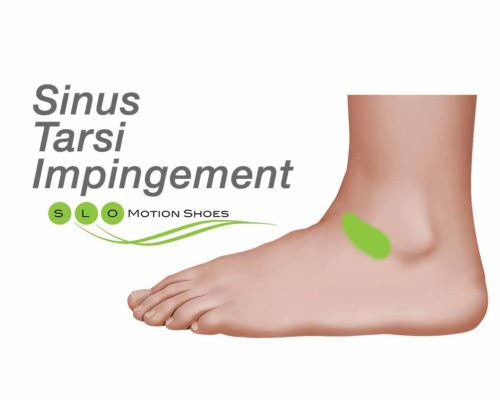The sinus tarsi is a small bony canal located below the ankle on the outside of your foot. It is the entrance of the subtalar joint which sits just below the ankle joint. The subtalar joint allows the foot to move in (invert) and out (evert) during walking. Inflammation or injury in the sinus tarsi region can cause significant pain and is referred to as sinus tarsi syndrome (STS).

Symptoms
Pain in the area just below and in front of ankle bone on outer side of foot
Pain worsens with weight-bearing activity
Pain may be “sharp” and “stabbing” or “achy” and “deep”
Tender to touch around outside and front of ankle
Pain with ankle movements, especially inversion (rolling inward) and plantarflexion (pointing foot down)
Feeling of instability in ankle
Causes
Ankle sprain caused by eversion (rolling out)
Impingement (pinching) of soft tissue in sinus tarsi due to excessive inversion (rolling in) of foot
Treatments
Treatment focus is on decreasing inflammation and supporting the foot by decreasing foot pronation (inward rolling). Conservative treatment is usually very effective if diagnosed early. Surgery is an option, but rarely necessary.
Avoid pain-causing activity during healing
Over the counter pain medication, such as ibuprofen (Advil, Motrin) or naproxen (Aleve), as needed
Ice to affected area
Cortisone injection
Orthotic and supportive shoe
Calf stretches
The sinus tarsi is the anatomic entrance of the subtalar joint which is located below the ankle on the outside region of the foot. The subtalar joint is a complex joint that sits just below the ankle joint. Whereas the ankle joint primarily moves the foot up and down in extension and flexion during walking the subtalar joint allows the foot to primarily move in and out or invert and evert during walking. Excessive pronation during walking can cause “pinching” to the fatty tissues that are present within the sinus tarsi region of the joint. This “pinching” or impingement can cause significant pain to this region of the foot.
The pain associated with sinus tarsi impingement is generally localized to the outside portion of the foot at the sinus tarsi. It is described often as a pinching sensation or sharp, lacinating pain worse upon initial weight bearing. The pain is readily reproducible by direct pressure into this region during an examination. The inversion and eversion of the foot during examination is usually not restricted. If there is limited motion with stiffness with attempted motion the suspicion of arthritis is heightened. The walking portion of the examination will always show significant abnormal foot pronation with the heel bone typically positioned everted or turned out to the floor surface. X-rays are generally not required but do help eliminate arthritis as a diagnosis.
Treatment focuses on decreasing inflammation to the tissues as well as supporting the foot by decreasing the extremes of foot pronation. Ice, anti-inflammatory medications like ibuprofen or naproxen can be helpful. A localized cortisone injection in the region tends to provide the most significant help in reducing the inflammation. An orthotic and supportive shoe is critical for recovery and must be used to decrease the impingement on the joint. If the shoe and orthotic are not worn faithfully during the time of recovery the pain will often return.







